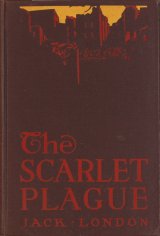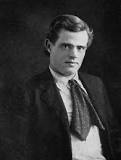The Scarlet Plague Page #6
"The Scarlet Plague" by Jack London, published in 1912, is a post-apocalyptic novel set in the year 2073, sixty years after a deadly pandemic—called the Scarlet Plague—wiped out most of humanity in 2013.
civilizations, new diseases arose, new kinds of germs entered their bodies. Thus were countless millions and billions of human beings killed. And the more thickly men packed together, the more terrible were the new diseases that came to be. Long before my time, in the middle ages, there was the Black Plague that swept across Europe. It swept across Europe many times. There was tuberculosis, that entered into men wherever they were thickly packed. A hundred years before my time there was the bubonic plague. And in Africa was the sleeping sickness. The bacteriologists fought all these sicknesses and destroyed them, just as you boys fight the wolves away from your goats, or squash the mosquitoes that light on you. The bacteriologists--” “But, Granser, what is a what-you-call-it?” Edwin interrupted. “You, Edwin, are a goatherd. Your task is to watch the goats. You know a great deal about goats. A bacteriologist watches germs. That's his task, and he knows a great deal about them. So, as I was saying, the bacteriologists fought with the germs and destroyed them--sometimes. There was leprosy, a horrible disease. A hundred years before I was born, the bacteriologists discovered the germ of leprosy. They knew all about it. They made pictures of it. I have seen those pictures. But they never found a way to kill it. But in 1984, there was the Pantoblast Plague, a disease that broke out in a country called Brazil and that killed millions of people. But the bacteriologists found it out, and found the way to kill it, so that the Pantoblast Plague went no farther. They made what they called a serum, which they put into a man's body and which killed the pantoblast germs without killing the man. And in 1910, there was Pellagra, and also the hookworm. These were easily killed by the bacteriologists. But in 1947 there arose a new disease that had never been seen before. It got into the bodies of babies of only ten months old or less, and it made them unable to move their hands and feet, or to eat, or anything; and the bacteriologists were eleven years in discovering how to kill that particular germ and save the babies. “In spite of all these diseases, and of all the new ones that continued to arise, there were more and more men in the world. This was because it was easy to get food. The easier it was to get food, the more men there were; the more men there were, the more thickly were they packed together on the earth; and the more thickly they were packed, the more new kinds of germs became diseases. There were warnings. Soldervetzsky, as early as 1929, told the bacteriologists that they had no guaranty against some new disease, a thousand times more deadly than any they knew, arising and killing by the hundreds of millions and even by the billion. You see, the micro-organic world remained a mystery to the end. They knew there was such a world, and that from time to time armies of new germs emerged from it to kill men. “And that was all they knew about it. For all they knew, in that invisible micro-organic world there might be as many different kinds of germs as there are grains of sand on this beach. And also, in that same invisible world it might well be that new kinds of germs came to be. It might be there that life originated--the 'abysmal fecundity,' Soldervetzsky called it, applying the words of other men who had written before him....” It was at this point that Hare-Lip rose to his feet, an expression of huge contempt on his face. “Granser,” he announced, “you make me sick with your gabble. Why don't you tell about the Red Death? If you ain't going to, say so, an' we'll start back for camp.” The old man looked at him and silently began to cry. The weak tears of age rolled down his cheeks and all the feebleness of his eighty-seven years showed in his grief-stricken countenance. “Sit down,” Edwin counselled soothingly. “Granser's all right. He's just gettin' to the Scarlet Death, ain't you, Granser? He's just goin' to tell us about it right now. Sit down, Hare-Lip. Go ahead, Granser.” III The old man wiped the tears away on his grimy knuckles and took up the tale in a tremulous, piping voice that soon strengthened as he got the swing of the narrative. “It was in the summer of 2013 that the Plague came. I was twenty-seven years old, and well do I remember it. Wireless despatches--” Hare-Lip spat loudly his disgust, and Granser hastened to make amends. “We talked through the air in those days, thousands and thousands of miles. And the word came of a strange disease that had broken out in New York. There were seventeen millions of people living then in that noblest city of America. Nobody thought anything about the news. It was only a small thing. There had been only a few deaths. It seemed, though, that they had died very quickly, and that one of the first signs of the disease was the turning red of the face and all the body. Within twenty-four hours came the report of the first case in Chicago. And on the same day, it was made public that London, the greatest city in the world, next to Chicago, had been secretly fighting the plague for two weeks and censoring the news despatches--that is, not permitting the word to go forth to the rest of the world that London had the plague. “It looked serious, but we in California, like everywhere else, were not alarmed. We were sure that the bacteriologists would find a way to overcome this new germ, just as they had overcome other germs in the past. But the trouble was the astonishing quickness with which this germ destroyed human beings, and the fact that it inevitably killed any human body it entered. No one ever recovered. There was the old Asiatic cholera, when you might eat dinner with a well man in the evening, and the next morning, if you got up early enough, you would see him being hauled by your window in the death-cart. But this new plague was quicker than that--much quicker. “From the moment of the first signs of it, a man would be dead in an hour. Some lasted for several hours. Many died within ten or fifteen minutes of the appearance of the first signs. “The heart began to beat faster and the heat of the body to increase. Then came the scarlet rash, spreading like wildfire over the face and body. Most persons never noticed the increase in heat and heart-beat, and the first they knew was when the scarlet rash came out. Usually, they had convulsions at the time of the appearance of the rash. But these convulsions did not last long and were not very severe. If one lived through them, he became perfectly quiet, and only did he feel a numbness swiftly creeping up his body from the feet. The heels became numb first, then the legs, and hips, and when the numbness reached as high as his heart he died. They did not rave or sleep. Their minds always remained cool and calm up to the moment their heart numbed and stopped. And another strange thing was the rapidity of decomposition. No
Translation
Translate and read this book in other languages:
Select another language:
- - Select -
- 简体中文 (Chinese - Simplified)
- 繁體中文 (Chinese - Traditional)
- Español (Spanish)
- Esperanto (Esperanto)
- 日本語 (Japanese)
- Português (Portuguese)
- Deutsch (German)
- العربية (Arabic)
- Français (French)
- Русский (Russian)
- ಕನ್ನಡ (Kannada)
- 한국어 (Korean)
- עברית (Hebrew)
- Gaeilge (Irish)
- Українська (Ukrainian)
- اردو (Urdu)
- Magyar (Hungarian)
- मानक हिन्दी (Hindi)
- Indonesia (Indonesian)
- Italiano (Italian)
- தமிழ் (Tamil)
- Türkçe (Turkish)
- తెలుగు (Telugu)
- ภาษาไทย (Thai)
- Tiếng Việt (Vietnamese)
- Čeština (Czech)
- Polski (Polish)
- Bahasa Indonesia (Indonesian)
- Românește (Romanian)
- Nederlands (Dutch)
- Ελληνικά (Greek)
- Latinum (Latin)
- Svenska (Swedish)
- Dansk (Danish)
- Suomi (Finnish)
- فارسی (Persian)
- ייִדיש (Yiddish)
- հայերեն (Armenian)
- Norsk (Norwegian)
- English (English)
Citation
Use the citation below to add this book to your bibliography:
Style:MLAChicagoAPA
"The Scarlet Plague Books." Literature.com. STANDS4 LLC, 2025. Web. 10 Mar. 2025. <https://www.literature.com/book/the_scarlet_plague_4294>.








Discuss this The Scarlet Plague book with the community:
Report Comment
We're doing our best to make sure our content is useful, accurate and safe.
If by any chance you spot an inappropriate comment while navigating through our website please use this form to let us know, and we'll take care of it shortly.
Attachment
You need to be logged in to favorite.
Log In